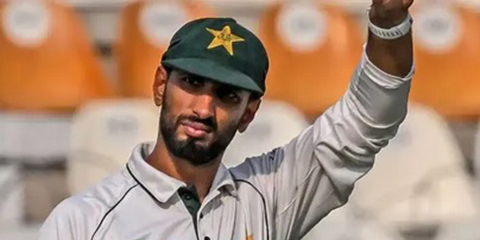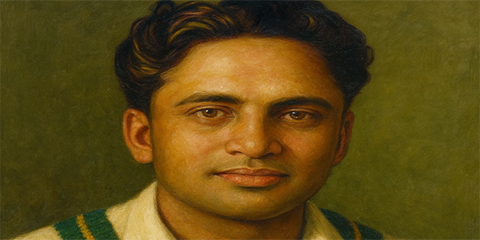From fortress to folly: Pakistan’s Test cricket decline
JournalismPakistan.com | Published 9 months ago | Dr. Nauman Niaz (TI)
Join our WhatsApp channel
Jomel Warrican, a slow left-arm orthodox spinner of modest stature in Test cricket, arrived in Pakistan as an unlikely protagonist, carrying a record that could scarcely be called illustrious—54 wickets in 17 Tests. Yet, in Pakistan where square turners were intended to serve as the host's unchallengeable bludgeon, Warrican found it productive to claim prominence. A cricketer often overshadowed by the rise of Gudakesh Motie, his more celebrated counterpart—Warrican's time was one of persistence, his place in the West Indies team usually arbitrary.
Warrican discovered the perfect theatre to craft his coup de grâce in the decay of Pakistan's batting inadequacies. With wiliness and intelligent variation of pace, he dismantled Pakistan’s line-up, exposing a collective ineptitude against spin bowling that bordered on incompetence. The result? Warrican ended the series with a remarkable 19 wickets, delivering a performance that turned the Pakistan team’s much-vaunted home advantage into a forbidding sardonicism.
The Test itself, ending in a comprehensive 120-run defeat for Pakistan, exposed their cricketing apparatus. Among the ruins of Pakistan’s batting order, only Saud Shakeel and Mohammad Rizwan displayed a modicum of competence. The remainder of the batting order was pedestrian at best, their technique and temperament unreservedly unsuited to the conditions they themselves had curated.
Failure of Strategy
The failure of Pakistan’s strategy could scarcely have been more damning. The preparation of a square-turning wicket, ostensibly to neutralize the West Indies batting, had a contrasting effect. Instead of exploiting perceived frailties, Pakistan became architects of their own downfall, enduing Warrican and Motie the stage upon which to succeed. Warrican’s mastery over the conditions, coupled with Motie and Kevin Sinclair’s subtle support, turned the Test into a damning indictment of Pakistan’s strategic naivety. Honestly, having already been ousted from the ICC World Test Championship 2023-2025, they weren’t required to prepare square turners instead they could have made sporting pitches and chosen young upcoming players on the team or provided chances to people like Imam Ul Haq endeavoring to make a return to the team.
Pakistan’s captain, Shan Masood, ’s leadership, marred by indecision and a lack of tactical nous, mirrored his mediocrity with the bat. Low offerings provided no solace to a team that looked bereft of inspiration under his captaincy. The selectors, whose whimsical changes and frequent upheavals had done little to instill stability, must also share the blame. The decision to bet on conditions without a thorough assessment of the opposition’s capabilities was symptomatic of deeper systemic failings.
The defeat was not just a loss in cricketing terms; it was a reflective unraveling of Pakistan’s cricketing identity. The romantic ideal of Pakistan as a nation of prodigious talent, capable of conjuring magic out of chaos, gave way to a sobering reality: their domestic structures and player development pipelines are no longer fit for purpose. The lack of a coherent vision, exacerbated by a revolving door of selectors and captains, has left the team adrift, unable to match the demands of contemporary Test cricket.
Jomel Warrican’s Triumph
Warrican’s triumph was as much a personal redemption as it was a broader commentary on Pakistan’s ineptitude. His series haul of 19 wickets underscored the potency of discipline and strategic intelligence over raw talent and misplaced bravado. It was a performance that echoed the timeless truth of cricket: it is not only a game of skill but a mental and philosophical conflict, where intelligence and adaptability often triumph over physical prowess.
As Warrican celebrated his match-winning five-wicket haul, culminating in the iconic thigh-thumping gesture that has become his hallmark, the symbolism was inescapable. Pakistan, once a proud cricketing nation, had been handed a bitter dose of their own medicine, undone by the very conditions they believed would serve as their fortress. The question now is not just how they recover from this loss but whether they possess the introspection to rebuild their cricketing edifice upon more solid structural foundations.
Shan Masood’s Mediocrity
Shan Masood, the batsman, managing to score above thirty on only two occasions in his last sixteen innings, and boasting a modest average of 30.12 across 42 Tests, is hardly the hallmark of resilience or enduring success. That he has persisted in Pakistan’s Test team despite such mediocrity speaks volumes, not only about individual fortune but about the flawed mechanisms governing Pakistan cricket. One might aptly describe him as a ‘captain of sweepers,’ such has been the defensive monotony of his methods, and yet his captaincy, encompassing 12 Tests, has brought a lamentable record of nine losses, evidence of strategic inadequacy and misplaced leadership.
Turning to Pakistan's bowling, the narrative grows no less complex. Noman Ali, the aging slow left-arm orthodox spinner, and Sajid Khan, the determined off-spinner, proved the linchpins of Pakistan’s spin attack. In the preceding home series against England, the two accounted for 39 of the 40 wickets in the final two Tests. Continuing their dominance, they picked a combined 15 wickets in the first Test against the West Indies, following it with another 16 in the second, an astounding aggregate of 70 dismissals in only eight innings. Such numbers, prima facie, suggest mastery, yet the devil lies in the details.
Despite the pitch being a veritable haven for slow bowlers, the series witnessed a curious anomaly. While Noman ended with 16 wickets and Sajid 15, Jomel Warrican, West Indies’ left-arm spinner, eclipsed them with a haul of 19 across the two Tests. This comparative success of an ostensibly lesser bowler is reflective of Pakistan's deeper malaise, a failure not of individual talent, but of collective temperament and tactical acumen.
The fragility of Pakistan’s strategies was starkly exposed by their inability to dismantle the West Indies tail. In the first innings of the opening Test, they had crumbled to 66-8, only to be inexplicably allowed a further 71 runs for the final two wickets. The second Test mirrored this pattern; after reducing the West Indies to 38-7 and then 54-8, Pakistan allowed them to accrue partnerships of 109 runs for the last two wickets in their first innings. These lapses were not just statistical footnotes but pivotal moments where the match, and with it the series, slipped from Pakistan’s hold.
Ironically, amidst these failings, Noman Ali achieved a historic personal milestone, becoming the first Pakistani spinner to pick a hat-trick in Test cricket. Yet, even this triumph was squandered, as defensive field settings and suboptimal bowling lengths nullified the advantage. Instead of attacking with precision, Pakistan's spinners delivered faster-than-required deliveries on a pitch crying out for guile and aggression. The setting at Multan, which should have been a fortress for Pakistan, thus became their undoing.
Frail Pakistan Batting
The batting order fared no better. Mohammad Huraira, a domestic hero with a triple and double century in his recent seasons, and Kamran Ghulam, who had announced his Test debut with a hundred against England, were both reduced to mediocrity when confronted with quality spin and a challenging pitch. Their captain, Shan Masood, himself a picture of inconsistency, could muster no resistance. Salman Ali Agha, often lauded as a proficient player of spin, floundered as well. Only Saud Shakeel and Mohammad Rizwan displayed glimpses of composure and technique befitting the conditions.
This was more than a cricketing failure; it was a truth-seeking reckoning. Pakistan’s insistence on preparing square turners, presumably to exploit the West Indies’ perceived weaknesses against spin backfired spectacularly. The defeat illuminated not only individual deficiencies but the systemic malaise afflicting Pakistan cricket. It was a vivid reminder of the age-old truth: in cricket, the most perilous adversary often lies within.
Babar Azam’s Predicament
Babar Azam’s lamentable form in Test cricket persists, largely due to his inability to amend glaring technical deficiencies. His struggle epitomises a broader malady within Pakistan’s cricketing edifice, a collective failure to adapt methods to the demands of a pitch or opposition. Many of Pakistan’s batsmen, on a surface necessitating prudence and adaptability, fell prey to recklessness. Whether by playing across the line or lunging forward to their peril, they met their demise in a manner almost self-inflicted. Such inadequacy reveals the wider frailties within Pakistan’s domestic cricket structure, where the pitches and the standard of First-Class cricket offer little by way of genuine preparation.
The pitches, on the whole, swing like a pendulum between extremes. Most are lifeless, unyielding pitches where the Dukes ball allows batsmen to compile monumental scores, double and triple centuries that serve more as a veneer, masking deeper flaws in technique. Elsewhere, conditions overly favor fast bowlers, leaving scant opportunity for spinners to ply their craft. Only a handful of wickets, particularly in Sindh or Karachi, offer genuine turn. This binary state of affairs results in batsmen who thrash spinners in domestic cricket but remain woefully ill-equipped to handle square turners at the international level. They lack the footwork, composure, and methods required to negotiate such challenges, culminating in repeated collapses and ignominy.
The roots of this crisis lie firmly in administrative incompetence. PCB’s inability to prioritize infrastructural development, invest in quality pitches, or adopt a modern, multi-disciplinary approach has left Pakistan cricket adrift. The tools that should underpin contemporary cricketing success—biomechanical and kinesiological assessments, real-time data, match-up analysis, and tailored technical insights are conspicuous by their absence. Added to this is the neglect of critical areas such as injury prevention, fitness regimes, workload management, and qualitative evaluations. It is, therefore, unsurprising that players like Kamran Ghulam and Mohammad Huraira appear ill-prepared for the rigors of international red-ball cricket.
Pakistan Cricket Living In Illusion
Indeed, the inadequacies of Pakistan’s batsmen extend further. They falter not only against spin but also against short, rising deliveries and the treble threats of seam and swing. Unable to navigate these fundamental challenges, their proficiency is relegated to the confines of T20 cricket, where field restrictions and bowlers’ preoccupation with economy rates grant batters the latitude to score freely. Thus, Pakistan cricket continues to exist in a realm of illusion, where denial of systemic failures becomes the norm.
Resistance to change and an endemic culture of mediocrity compound the problem. Relative insecurities, regional biases, and nepotism corrode the foundation of Pakistan cricket. Political appointments, whimsical decision-making, and an over-reliance on opportunistic ex-cricketers cycling through administrative roles for which they are ill-suited, further entrench these issues. Intellectual dishonesty, arbitrary policies, and deficiencies within the PCB’s constitution underscore a governance model that is as fragmented as it is inept.
In essence, Pakistan cricket’s afflictions are not just technical or strategic but existential. The game’s essence, the artistry, resilience, and integrity that once defined it has been sacrificed at the altar of incompetence and self-interest. It is a tragedy of high proportions, a narrative where ambition falters before hubris, and the collective soul of a cricketing nation teeters on the edge of oblivion.
Dr. Nauman Niaz is the Sports Editor at JournalismPakistan.com. He is a civil award winner (Tamagha-i-Imtiaz) in Sports Broadcasting and Journalism and a regular cricket correspondent, covering 54 tours and three ICC World Cups. He has written over 3500 articles, authored 14 books, and is the official historian of Pakistan cricket (Fluctuating Fortunes IV Volumes – 2005). His signature show, Game On Hai, has received the highest ratings and acclaim.

























